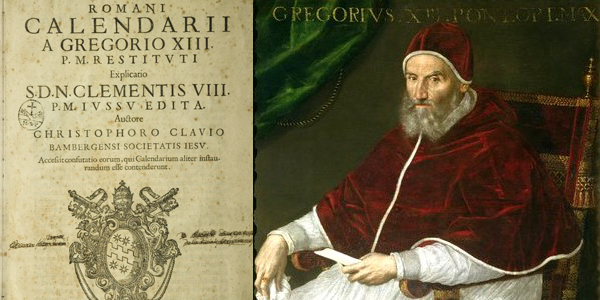The Julian calendar (which Julius Caesar established in the Roman Empire in 46 BC, hence its name) sought to adjust chronological time to cosmological time, so that certain festivities could coincide with certain astronomical moments (mainly equinoxes and solstices), thus recovering the Egyptian tradition that divided the year into 12 months.
According to the Julian calendar, one year comprised 365 days and six hours (which is the time it takes for the planet to complete its translational movement orbiting the sun).
But a failure in the calculation of the decimals led to a mismatch of 11 minutes, which required the addition of a leap year every four years, adding an extra day between February 24 and 25 in the years divisible by four. (If it sounds complicated, that’s because it is.) And precisely because of such complications, Pope Gregory XIII introduced a series of modifications in 1582.
In a nutshell, the problem of the Julian calendar lay basically in the fact that it lagged the seasons of the year, and consequently the liturgical festivities were always celebrated later and later each year. Attempts to fix liturgical celebrations with a certain time of the year had already been set in the Council of Nicaea, which had the astronomical event the celebration of Easter (for example) should be matched.
Read more:
When is Easter Sunday?
Thus, Pope Gregory XIII ordered a scientific commission, which included the Italian chronologist Luis Lilio, the Jesuit Christophorus Clavius, the cosmographer Ignazio Danti and the Spanish mathematician Pedro Chacón, to create the calendar that we use today and which, for obvious reasons, we call Gregorian. The aim was to fix the Spring Equinox of the Northern Hemisphere on March 21 rather than on March 11, as was occurring according to the Julian calendar by the beginning of the 16th century.
The commission thus modified the Julian calendar, maintaining the leap years whose last two figures were divisible by four, but at the same time eliminating those that coincided with each centennial, and also those that could be divided by 400. Indeed, it isn’t any less complex than the Julian calendar but, in short, the Gregorian sets 97 leap years out of 400, while that of Julius Caesar included 100.
As soon as the calendar changed, October 4, 1582 became October 15, 1582 on the very same day, and 10 days suddenly disappeared. Countries that adopted the calendar passed from October 4 to October 15 in a single night. This explains, for example, why St. Teresa of Avila, who died in Alba de Tormes on October 4 of that same year, was buried on October 15 — now her feast day. Just 24 hours after her death, we shifted from the Julian to the Gregorian calendar.
Not everyone adopted the Gregorian calendar right away. In its Alexandrian form, for example, it is still the official civil calendar of Ethiopia. Most Eastern Orthodox Churches still follow the Julian calendar for the purpose of calculating the date of Easter and its related movable feasts. Among the religious or state calendars that do not count years from the birth of Christ are the Jewish, Muslim, Chinese, and Vietnamese calendars.

